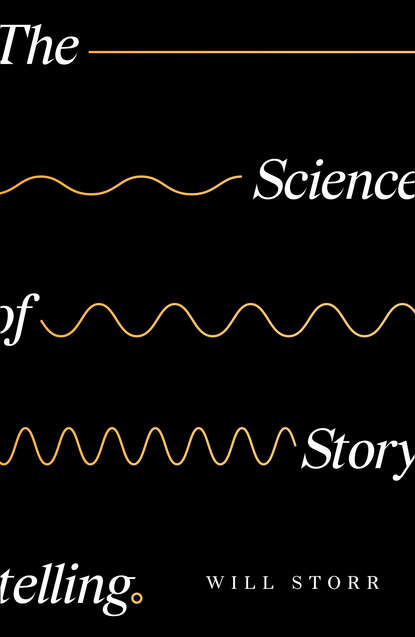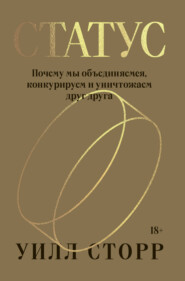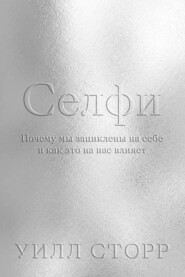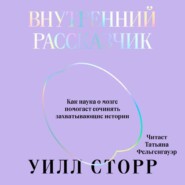По всем вопросам обращайтесь на: info@litportal.ru
(©) 2003-2024.
✖
The Science of Storytelling
Автор
Год написания книги
2019
Настройки чтения
Размер шрифта
Высота строк
Поля
2.8 How flawed characters create meaning (#litres_trial_promo)
CHAPTER THREE: THE DRAMATIC QUESTION (#litres_trial_promo)
3.0 Confabulation and the deluded character; the dramatic question (#litres_trial_promo)
3.1 Multiple selves; the three-dimensional character (#litres_trial_promo)
3.2 The two levels of story; how subconscious character struggle creates plot (#litres_trial_promo)
3.3 Modernist stories (#litres_trial_promo)
3.4 Wanting and needing (#litres_trial_promo)
3.5 Dialogue (#litres_trial_promo)
3.6 The roots of the dramatic question; social emotions; heroes and villains; moral outrage (#litres_trial_promo)
3.7 Status play (#litres_trial_promo)
3.8 King Lear; humiliation (#litres_trial_promo)
3.9 Stories as tribal propaganda (#litres_trial_promo)
3.10 Antiheroes; empathy (#litres_trial_promo)
3.11 Origin damage (#litres_trial_promo)
CHAPTER FOUR: PLOTS, ENDINGS AND MEANING (#litres_trial_promo)
4.0 Goal directedness; video games; personal projects; eudaemonia; plots (#litres_trial_promo)
4.1 Plot as recipe versus plot as symphony of change (#litres_trial_promo)
4.2 The final battle (#litres_trial_promo)
4.3 Endings; control; the God moment (#litres_trial_promo)
4.4 Story as a simulacrum of consciousness; transportation (#litres_trial_promo)
4.5 The power of story (#litres_trial_promo)
4.6 The lesson of story (#litres_trial_promo)
4.7 The consolation of story (#litres_trial_promo)
APPENDIX: THE SACRED FLAW APPROACH (#litres_trial_promo)
A NOTE ON THE TEXT (#litres_trial_promo)
ACKNOWLEDGMENTS (#litres_trial_promo)
NOTES AND SOURCES (#litres_trial_promo)
INDEX (#litres_trial_promo)
ABOUT THE AUTHOR (#litres_trial_promo)
ALSO BY WILL STORR (#litres_trial_promo)
ABOUT THE PUBLISHER (#litres_trial_promo)
INTRODUCTION (#ulink_ee20cb80-193d-5a77-90b5-02c200420e27)
We know how this ends. You’re going to die and so will everyone you love. And then there will be heat death. All the change in the universe will cease, the stars will die, and there’ll be nothing left of anything but infinite, dead, freezing void. Human life, in all its noise and hubris, will be rendered meaningless for eternity.
But that’s not how we live our lives. Humans might be in unique possession of the knowledge that our existence is essentially meaningless, but we carry on as if in ignorance of it. We beetle away happily, into our minutes, hours and days, with the fact of the void hovering over us. To look directly into it, and respond with an entirely rational descent into despair, is to be diagnosed with a mental-health condition, categorised as somehow faulty.
The cure for the horror is story. Our brains distract us from this terrible truth by filling our lives with hopeful goals and encouraging us to strive for them. What we want, and the ups and downs of our struggle to get it, is the story of us all. It gives our existence the illusion of meaning and turns our gaze from the dread. There’s simply no way to understand the human world without stories. They fill our newspapers, our law courts, our sporting arenas, our government debating chambers, our school playgrounds, our computer games, the lyrics to our songs, our private thoughts and public conversations and our waking and sleeping dreams. Stories are everywhere. Stories are us.
It’s story that makes us human. Recent research suggests language evolved principally to swap ‘social information’ (#litres_trial_promo) back when we were living in Stone Age tribes. In other words, we’d gossip. We’d tell tales about the moral rights and wrongs of other people, punish the bad behaviour, reward the good, and thereby keep everyone cooperating and the tribe in check. Stories about people being heroic or villainous, and the emotions of joy and outrage they triggered, were crucial to human survival. We’re wired to enjoy them.
Some researchers believe grandparents came to perform a vital role in such tribes (#litres_trial_promo): elders told different kinds of stories (#litres_trial_promo) – about ancestor heroes, exciting quests and spirits and magic – that helped children to navigate their physical, spiritual and moral worlds. It’s from these stories that complex human culture emerged. When we started farming and rearing livestock, and our tribes settled down and slowly merged into states, these grandparental campfire tales morphed into great religions that had the power to hold large numbers of humans together. Still, today, modern nations are principally defined by the stories we tell about our collective selves: our victories and defeats; our heroes and foes; our distinctive values and ways of being, all of which are encoded in the tales we tell and enjoy.
We experience our day-to-day lives in story mode. The brain creates a world for us to live in and populates it with allies and villains. It turns the chaos and bleakness of reality into a simple, hopeful tale, and at the centre it places its star – wonderful, precious me – who it sets on a series of goals that become the plots of our lives. Story is what brain does. It is a ‘story processor’, writes the psychologist Professor Jonathan Haidt (#litres_trial_promo), ‘not a logic processor’. Story emerges from human minds as naturally as breath emerges from between human lips. You don’t have to be a genius to master it. You’re already doing it. Becoming better at telling stories is simply a matter of peering inwards, at the mind itself, and asking how it does it.
This book has an unusual genesis in that it’s based on a storytelling course that is, in turn, based on research I’ve carried out for various books. My interest in the science of storytelling began about a decade ago when I was working on my second book, The Heretics, which was an investigation into the psychology of belief. I wanted to find out how intelligent people end up believing crazy things. The answer I found was that, if we’re psychologically healthy, our brain makes us feel as if we’re the moral heroes at the centre of the unfolding plots of our lives. Any ‘facts’ it comes across tend to be subordinate to that story. If these ‘facts’ flatter our heroic sense of ourselves, we’re likely to credulously accept them, no matter how smart we think we are. If they don’t, our minds will tend to find some crafty way of rejecting them. The Heretics was my introduction to the idea of the brain as a storyteller. It not only changed the way I saw myself, it changed the way I saw the world.
It also changed the way I thought about my writing. As I was researching The Heretics, I also happened to be working on my first novel. Having struggled with fiction for years I’d finally buckled and bought a selection of traditional ‘how-to’ guides. Reading through them, I noticed something odd. Some of the things the story theorists were saying about narrative were strikingly similar to what the psychologists and neuroscientists I’d been interviewing had been telling me about brain and mind. The storytellers and the scientists had started off in completely different places and had ended up discovering the same things.
As I continued my research, for subsequent books, I continued making these connections. I started to wonder if it might be possible to join the two fields up and thereby improve my own storytelling. That ultimately led to my starting a science-based course for writers which turned out to be unexpectedly successful. Being faced regularly with roomfuls of extremely smart authors, journalists and screenwriters pushed me to deepen my investigations. Soon, I realised I had about enough stuff to fill a short book.
My hope is that what follows will be of interest to anyone curious about the science of the human condition, even if they have little practical interest in storytelling. But it’s also for the storytellers. The challenge any of us faces is that of grabbing and keeping the attention of other people’s brains. I’m convinced we can all become better at what we do by finding out a bit about how they work.
This is an approach that stands in contrast to more traditional attempts at decoding story. These typically involve scholars comparing successful stories or traditional myths from around the world and working out what they have in common. From such techniques come predefined plots that put narrative events in a sequence, like a recipe. The most influential of these is undoubtedly Joseph Campbell’s ‘Monomyth’ (#litres_trial_promo), which, in its full form, has seventeen parts that track the phases of a hero’s journey from their initial ‘call to adventure’ onwards.
Such plot structures have been hugely successful. They’ve drawn crowds of millions and dollars by the billions. They’ve led to an industrial revolution in yarn-spinning that’s especially evident in cinema and long-form television. Some examples, such as the Campbell-inspired Star Wars: A New Hope, are wonderful. But too many more are Mars Bar stories, delicious and moreish but ultimately cold, corporate and cooked up by committee.
For me, the problem with the traditional approach is that it’s led to a preoccupation with structure. It’s easy to see why this has happened. Often the search has been for the One True Story – the ultimate, perfect plot structure by which every tale can be judged. And how are you going to describe that if not by dissecting it into its various movements?
I suspect it’s this emphasis on structure that’s responsible for the clinical feel from which many modern stories suffer. I believe the focus on plot should be shifted onto character. It’s people, not events, that we’re naturally interested in. It’s the plight of specific, flawed and fascinating individuals that makes us cheer, weep and ram our heads into the sofa cushion. The surface events of the plot are crucial, of course, and structure ought to be present, functional and disciplined. But it’s only there to support its cast.
While there are general structural principles, and a clutch of basic story shapes which are useful to understand, trying to dictate obligatory dos and don’ts that go beyond these extremely broad outlines is probably a mistake. A journey into the science of storytelling reveals that there are many things that attract and hold the attention of brains. Storytellers engage a number of neural processes that evolved for a variety of reasons and are waiting to be played like instruments in an orchestra: moral outrage, unexpected change, status play, specificity, curiosity, and so on. By understanding them, we can more easily create stories that are gripping, profound, emotional and original.
This, I hope, is an approach that will prove more creatively freeing. One benefit of understanding the science of storytelling is that it illuminates the ‘whys’ behind the ‘rules’ we’re commonly given. Such knowledge should be empowering. Knowing why the rules are the rules means we know how to break them intelligently and successfully.
But none of this is to say we should disregard what story theorists such as Campbell have discovered. On the contrary. Many popular storytelling books contain brilliant insights about narrative and human nature that science has only recently caught up with. I quote a number of their authors in these pages. I’m not even arguing that we should ignore their valuable plot designs – they can easily be used to complement this book. It’s really just a question of emphasis. I believe that compelling and unique plots are more likely to emerge from character than from a bullet-pointed list. And the best way to create characters that are rich and true and full of narrative surprise is to find out how characters operate in real life – and that means turning to science.
I’ve tried to write the storytelling book I wish I’d had, back when I was working on my novel. I’ve tried to balance The Science of Storytelling in such a way that it’s of practical use without killing the creative spirit by issuing lists of ‘You Musts’. I agree with the novelist and teacher of creative writing John Gardner (#litres_trial_promo), who argues that ‘most supposed aesthetic absolutes prove relative under pressure’. If you’re embarking on a storytelling project, I’d suggest you view what follows not as a series of obligations, but as weapons you can choose if and how to deploy. I’ve also outlined a practice that’s proved successful in my classes over the years. The ‘Sacred Flaw Approach’ is a character-first process, an attempt to create a story that mimics the various ways a brain creates a life, and which therefore feels true and fresh, and comes pre-loaded with potential drama.









